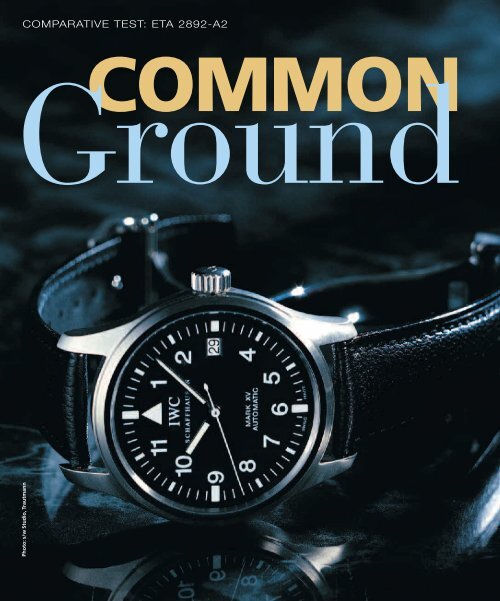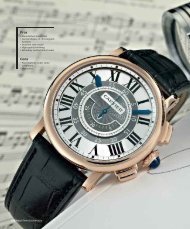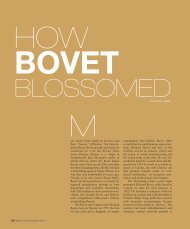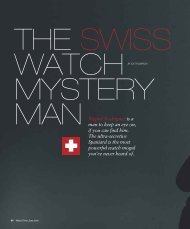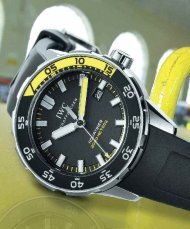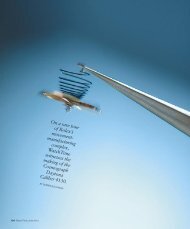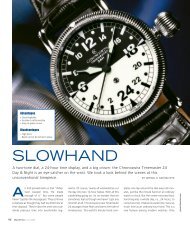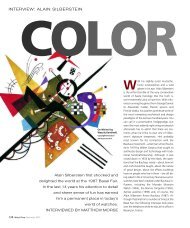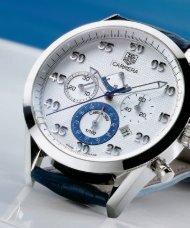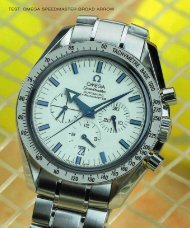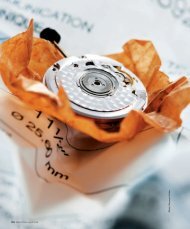WT_2002_06: COMPARATIVE TEST: ETA 2892-A2
WT_2002_06: COMPARATIVE TEST: ETA 2892-A2
WT_2002_06: COMPARATIVE TEST: ETA 2892-A2
- No tags were found...
You also want an ePaper? Increase the reach of your titles
YUMPU automatically turns print PDFs into web optimized ePapers that Google loves.
<strong>COMPARATIVE</strong> <strong>TEST</strong>: <strong>ETA</strong> <strong>2892</strong>-<strong>A2</strong>COMMONGroundPhoto: s/w Studio, Trautmann
The <strong>ETA</strong> <strong>2892</strong>-<strong>A2</strong> has beenaround for more than 25years, and during the pastquarter century, themovement has beenencased within an immenserange of watches.We decided to pit the IWCMark XV, the ChronoswissKairos and the LonginesAvigation against each other.All three are powered by<strong>ETA</strong>’s intrepid bestseller.BY WITOLD A. MICHALCZYK
<strong>COMPARATIVE</strong> <strong>TEST</strong>: <strong>ETA</strong> <strong>2892</strong>-<strong>A2</strong>movement. Nearly all critical componentsalong the path from the escapement to themainspring are removed from the movementand replaced with corresponding componentsfrom IWC’s own manufacture. The escapementand balance are optimally fine-tunedand painstakingly adjusted.Unfortunately, the Mark XV’s owner rarelyhas an opportunity to admire all of these manychanges and improvements because thewatch’s screw-in back is not fitted with a trans-Aficionados of manufacture movementswill undoubtedly sniff at anymention of <strong>ETA</strong>. Boring, mass-producedmerchandise, they’ll say. Well, we say,No way! Manufactured since 1975, <strong>ETA</strong>’s Caliber<strong>2892</strong> outdoes nearly every other caliber interms of its versatility. As the decades advanced,countless add-on modules were developedfor this movement so that the updated<strong>ETA</strong> <strong>2892</strong>-<strong>A2</strong> could serve as the powerplantfor timepieces with power-reserve displays,retrograde seconds, displays of time in a secondtime zone, chronograph functions, andfive-minute repetition. Lest all these complicationsdazzle us, we also shouldn’t forget thatthere are also plenty of very pretty <strong>2892</strong>-<strong>A2</strong>sticking away inside simple three-handedwatches.The IWC Marx XV, which sells for $3,000 isthe most expensive of our three candidates.Not only does its price make it a temptingwatch with which to begin your serious collection,in many other respects its noble attributesdistinguish it as the most interesting of ourtrio. Although this pilot’s watch is powered bya <strong>2892</strong>-<strong>A2</strong>, the watchmakers in Schaffhausen,Switzerland have gone to the trouble of so luxuriouslyrebuilding the base caliber that youcould almost describe it as a total revision. Themost immediately notable feature of the modifiedcaliber is the gold plating. After IWC hassubjected the caliber to comprehensive upgrading,it operates with significantly less frictionand its balance swings through a largerarc. IWC insists on closer tolerances for endshake,meshing, and truing in the flat than <strong>ETA</strong>permits. A lever is individually made for eachA rare view into the comprehensively rebuilt<strong>ETA</strong> <strong>2892</strong>-<strong>A2</strong> that’s used in the IWC Mark XV.The case of the Mark XV shields the caliber against magnetism. Sturdy and beautiful:the folding clasp of the Mark XV.DATA PAGEIWC Mark XVManufacturer: IWCModel: Mark XVFunctions: Hours, minutes, seconds, date.Movement: IWC C.37524, based on an <strong>ETA</strong><strong>2892</strong>-<strong>A2</strong>, mechanical with automatic winding,diameter = 25.6 mm, height = 3.57 mm, 21jewels, 28,800 beats per hour, fine adjustmentvia eccentric, Incabloc shock absorption,40-hour power reserve, screw-down crown,water-resistant to 6 atmospheres.Case: Stainless steel case, sapphire crystal,screw-in back.Wristband and clasp: Buffalo leather wristbandwith stainless steel folding clasp.Results of running test:(deviations in seconds per 24 hours):Dial up: +2Dial down: +1Crown right: 0Crown left: -2.5Crown down: 0Crown up: -4Greatest rate difference: 6Average deviation: 0.5Average (max.) amplitude: 300°Dimensions: Diameter = 38 mm,height = 9 mm. Weight: 56 g.Price: $2,995parent window. Even after unscrewing theopaque metal back, the movement still remainshidden from view because IWC hasequipped the watch with a soft iron inner caseto protect the caliber from the deleterious ef-96 WatchTime December <strong>2002</strong>
<strong>COMPARATIVE</strong> <strong>TEST</strong>: <strong>ETA</strong> <strong>2892</strong>-<strong>A2</strong>fects of magnetic fields. Only after the innercase has been removed can you feast your eyeson the Caliber C.37524, which is the referencenumber IWC uses to designate this revampedmovement. The fine-tuning given to the caliberby IWC was unmistakably apparent on ourtester’s timing machine, which registered anaverage deviation of just 0.5. Our advisor forthis test, Rainer Merath, the owner of KernerJewelry and Watches in Ulm, Germany, admittedhe rarely encounters such a tiny deviationduring timing trials.The Kairos debuted in 1989and is named after the Greekgod of auspicious moments.Compared to its predecessor (the Mark XII),the Mark XV has grown two millimeters larger.That may not seem like much expansion, butbecause the watch looks fairly small, every littlebit of extra size helps. At the same time, itsoverall height was decreased by 1.5 millimeters,despite the fact that the movement itselfis thicker than its forerunner. Although the remainingelements of design were transferredunchanged, these two alterations make theDATA PAGEChronoswiss KairosManufacturer: ChronoswissModel: KairosFunctions: Hours, minutes, seconds, date.Movement: <strong>ETA</strong> <strong>2892</strong>-<strong>A2</strong>, mechanical withautomatic winding, diameter = 25.6 mm,height = 3.57 mm, 21 jewels, 28,800 beatsper hour, fine adjustment via eccentric, Incablocshock absorption, 42-hour power reserve,bridge with cloud pattern, skeletonized rotor.Case: Stainless steel case, sapphire crystal,sapphire crystal case back.Wristband and clasp: Crocodile-skinwristband with pronged buckle.Results of running test:(deviations in seconds per 24 hours):Dial up: +5Dial down: +7Crown right: 0Crown left: 0Crown down: +1Crown up: +2.5Greatest rate difference: 6Average deviation: +2.5Dimensions: Diameter = 38 mm,height = 9.5 mm. Weight: 55 g.Price: $2,400The skeletonized rotor has two “windows”through which you can see the movement.Mark XV look much younger and fresher.Satin-finished steel is only one reason why itscase well suits the image that you might demandfrom a modern, high-quality wristwatch.The handling of the details is so goodthat no shortcomings could be found. Just theopposite, in fact: the closer you look, the moreexcellence you discover, such as the bevelingat the edges of the lugs. The Mark XV is alsothe only watch in our test that offers a screwdowncrown. The crown itself isn’t especiallylarge, but its size and design are good matchesfor the Mark XV’s overall look. The crown isalso readily grasped and very pleasant to operate.Some critics might complain that the MarkXV’s appearance is somewhat too austere, butwe think that in this case austerity in designhas led to very attractive contours.Clear contours and a reduction to the bareessentials also characterize the look of thedial. Compared to its predecessor, the handsand indices on the Mark XV have gained a littleweight. The Mark XV is also the only one ofour three candidates to offer a date windowat the 3 o’clock position. The date beside the“3” (rather than down at the “6”) seems awee bit conservative and interferes with theAbove: The Kairos reflects Gerd-RüdigerLang’s penchant for classical shapes.Below: Chronoswiss insists on perfection,even in the smallest of details.98 WatchTime December <strong>2002</strong>
<strong>COMPARATIVE</strong> <strong>TEST</strong>: <strong>ETA</strong> <strong>2892</strong>-<strong>A2</strong>Longines hasn’t made many changes in the stock <strong>ETA</strong> <strong>2892</strong>-<strong>A2</strong>.DATA PAGELongines AvigationManufacturer: LonginesModel: AvigationFunctions: Hours, minutes, seconds, date.Movement: L619, based on an <strong>ETA</strong> <strong>2892</strong>-<strong>A2</strong>,mechanical with automatic winding, diameter =25.6 mm, height = 3.57 mm, 21 jewels, 28,800beats per hour, fine adjustment via eccentric, Incablocshock absorption, 42-hour power reserve,bridge with cloud pattern.Case: Stainless steel case, sapphire crystal,sapphire crystal case back.Wristband and clasp: Reptile-skin wristbandwith pronged buckle.Results of running test:(deviations in seconds per 24 hours):Dial up: -1Dial down: +3Crown right: +5Crown left:: +4Crown down: -1Crown up: 0Greatest rate difference: 6Average deviation: 1.5Average (max.) amplitude: 280°Dimensions: Diameter = 38.5 mm,height = 9.1 mm. Weight: 55 g.Price: $1,195A side view of the Avigation highlights itsslender, sporty profile. The crown has a nicefeel, but is a little too large.otherwise pleasing harmony of the overall appearance.The stalk-type hands aren’t exactlygraceful beauties, but their lengths are justright and even the most cursory glance can soeasily distinguish between the three differenthands that you can even tell the time of daywhen you’re flying through a summer thunderstormin a jittery little Cessna. If you everfind yourself trying to perform that stunt in themiddle of the night, five luminous tritiummarkings will help keep you oriented, at leastas far as the time is concerned. A domed sapphirecrystal covers the dial. The crystal, inci-The clasp is a good match for the watch’s style.Unfortunately the piece of leather that protectsthe wrist isn’t perfectly sewn.dentally, fits so securely that IWC promisesthat it will also be able to withstand a suddenplunge in cabin pressure. We opted not to putthat promise to the test, but can assure youthat when danger threatens; you can rely onIWC’s Mark XV.The buffalo leather wristband is excellentlycrafted. From start to finish, it evinced greatersuppleness than the wristbands of the othertwo candidates in our comparative test. Thefolding clasp is very beautiful, but operatingthe one on our test watch required a bit ofbrute force.Timepieces from the House of Chronoswisscan hardly be described without using the often-repeatedadjective “classical.” But that epithetis no mere platitude here, as Gerd-RüdigerLang readily admits that his watches run“100 years slow.” Scarcely any other brandhas become such a trendsetter by virtue of itsuncompromising refusal to get with the times.The Kairos, which debuted in 1989, derives itsname from Ancient Greek mythology. Thismodel bears the same name as the Hellenicgod of the “auspicious moment.” You couldargue that anyone who wears this watch is indanger of losing track of time – not because ofany shortcoming inherent in the wristwatch,whose dial is readily legible – but because itsface is so beguiling that you might lose yourselfin contemplation of beauty and forgetwhat time it’s getting to be. Lovely guillochédecorations expand in concentric circles fromthe midpoint of its dial. The large numerals arearranged on a smooth annulus, followed bythe somewhat smaller strokes, dots, and digitsof the minute-circle that form a ring aroundthe hour indices. The date window is cleverlylocated above the “6,” where it provides visualcounterweight to the “12,” a numeral100 WatchTime December <strong>2002</strong>
which, by it very nature, necessarily lookssomewhat heavier than all the others withwhich it shares the dial. The brand name andthe name of the watch are unobtrusivelyaligned along the central, vertical axis between“6” and “12.” Notwithstanding the classicismof several stylistic elements, this focus on thewatch’s essentials is thoroughly modern. The38-mm diameter is regarded as a comfortablestandard for today’s wrists, although when theKairo debuted, it ranked among the largerwatches in its class.And yet, to describe the Kairos as a “modern”wristwatch wouldn’t do justice to Lang’sidea, at least if you substituted “modern” for“fashionable.” The Kairos’ modernity derivesThe roots of the LonginesAvigation can be tracedto 1920, when a navigationinstructor developed the firstgenuine pilot’s watch.from its timeless design. Although it was bornduring the aftershocks of the 1980s, its formcan still effortlessly hold its own against any<strong>2002</strong> competitors. Other manufacturers havefrequently tried to imitate the classic characteristicsof the Kairos, but their copying merelyapes its surface design without getting to theheart of its perfection, which is in the details.While other brands strive to reduce the numberof components, the lavishness of Lang’sapproach seems almost extravagant: The casealone is constructed from 19 separate parts.The same austere clarity that we admired onthe dial is continued within the 9.5-mm-tallcylinder of the case. Despite the case’s somewhatunergonomic form, the extreme downwardcurvature of the lugs ensures that thiswatch fits comfortably on the wrist. The channeledbezel, which has practically become atrademark for Chronoswiss, rounds the edgesof the case far enough so that the watch won’tsnag on even the closest-fitting shirt cuff. Theelaborate construction of the case notwithstanding,this watch is water-resistant to 30meters. You can search for luminous indices,but you won’t find them, as the application ofluminous material to the blued-steel Breguetstylehands would rob these indicators of theircharm. If you want to read the time from thiswatch during the night, you’ll need to rely onother sources of light. If your surroundingsaren’t absolutely as black as midnight, thenthe clear structure of the dial and the perfectlengths of the hands will facilitate the timetellingtask. The hands have been kept rathernarrow, but good legibility is assured by theirazure color, which contrasts extremely wellwith the silvery hue of the dial.The steel hands on Lang’s watches aren’tmere off-the-shelf items: Each one is manuallycurved, sharpened to a rapier-like point, andcarefully polished. True to tradition, the eyeletson these Breguet-style hands are asymmetricallyfiled. The fruits of all this effort are gracefulblue beauties of a kind that’s seldom seenon other brands’ watches. In a lean era whichhas made efficiency and cost-cutting its firstand second commandments, Lang’s perfectionismseems almost anachronistic. TheKairos positively invites close scrutiny, and anyonewho takes the time to really look closelywill no doubt appreciate the differences. Twoother details that distinguish Lang’s timepiecesfrom the also-rans are the screws on the wristband’scrosspiece and clasp, where Chronoswissuses its patented Autobloc system. It<strong>TEST</strong> RESULTS: IWC MARK XV CHRONOSWISS KAIROS LONGINES AVIGATIONWristband and clasp(max. 10 points): 7 9 7Operation (5): 5 4 5Case (10): 8 10 7Design (15): 14 13 11Legibility (5): 5 4 5Wearing comfort (10): 8 8 7Movement (20): 13 12 11Results of running test (10): 8 8 8Overall value (15): 11 12 11TOTAL: 79 80 72
In the wake of comprehensive reforms in responseto the Quartz Crisis, SSIH (Société Suissepour l’Industrie horlogère S.A.), ASUAG, and thusalso the several companies which were formerlysubsidiaries of Ebauches S.A. were all absorbed bySMH Concern (Société Suisse de Microélectroniqueet d’horlogerie), which was jointly foundedby charismatic super entrepreneur Nicolas G.Hayek and a consortium of renowned banks. Allébauche-related activities were brought togetherunder the aegis of the new <strong>ETA</strong> S.A., a subsidiaryof SMH.Without <strong>ETA</strong>’s tremendous production potentialand broad spectrum of calibers, many ofSwitzerland’s watch brands would have beenforced to stop making watches. Despite (or perhapsbecause of) <strong>ETA</strong>’s large-series production, itsproducts distinguish themselves as paragons ofprecision and reliability. Furthermore, respectedluxury brands (e.g. Frank Muller or IWC) rely ontried-and-tested calibers such as the <strong>ETA</strong> <strong>2892</strong>, or,to be more precise, the updated version of that caliber,which bears the reference number <strong>2892</strong>-<strong>A2</strong>.This flat, self-winding movement with central,ball-borne rotor debuted in 1975. To competewith the precise rate of electronic timepieces, inthis and other mechanical calibers <strong>ETA</strong> relied onan easy-to-handle balance frequency of 28,800beats per hour or four-hertz. Compared to thelikewise available five-hertz (36,000-beat-perhour)calibers, the slower heartbeat combines adequateprecision with relatively minor and easilymastered technical difficulties.<strong>ETA</strong> and Its Best-selling Caliber <strong>2892</strong>-<strong>A2</strong>The <strong>2892</strong>-<strong>A2</strong> also embodies principles in itsself-winding construction group which <strong>ETA</strong> hadalready used successfully for many years. Theseprinciples include the patented, ball-borne rotorwhich had been developed for Eterna in 1947, theautomatic gear-train with an efficient click-wheelalternator to polarize the rotor’s motions so thatthe oscillating weight can wind the mainspring inboth of its directions of rotation, easy servicingthanks to modular construction, and reduction ofthe entire device to the fewest possible components.When fully wound, the barrel storesenough energy to keep the watch running for 42hours. Rapid adjustment for the date display, a directlypropelled “sweep” seconds-hand, an eccentricto adjust the regulator’s tail, and a balance-stopfunction to facilitate to-the-second settingof the time likewise number among this calibersstandard features.Considering all of these attributes, the caliber’sdimensions needn’t fear comparison with exclusive,small-series calibers. Its diameter is 111/2lignes (25.6 mm) and its height is 3.6 mm. Whena caliber-savvy watch aficionado sees those figures,he or she is likely to be reminded of the legendaryEterna-Matic 3000, which celebrated itspremiere in 1963. This extra-flat wristwatch originallyencased the Caliber 1466 with a balance frequencyof 18,000 beats per hour (2.5 hertz). Later,this leisurely paced ticker was replaced by theCaliber 1505, whose balance completes 21,600beats every hour. Like the <strong>2892</strong>, these automaticmovements supported date displays and were amere 3.6-mm slim. It thus seems likely that theCaliber <strong>2892</strong> was originally based on these trailblazingcalibers.Of course, <strong>ETA</strong>’s technicians continued to refinethe caliber during its production phase. Theoptimized version, which was first marketed in1983, bears the reference number <strong>2892</strong>-<strong>A2</strong>.The <strong>2892</strong>-<strong>A2</strong> belongs to the “Mecaline” categoryin <strong>ETA</strong>’s current spectrum of movements. Thecompany distinguishes between simple calibers(“Standard”) and extra-flat, highly complicatedmovements (“Specialties”).Generally speaking, worlds of difference canseparate one specimen of a <strong>2892</strong>-<strong>A2</strong> from another.<strong>ETA</strong> offers this caliber in the “normal” version(the basic, plain-vanilla item), as well as in an“elaborate” version. Additionally, <strong>ETA</strong> also makesgold-plated movements and crafts special editionswith Incabloc shock absorption, Nivaflex-1mainspring, and better adjustment. If that’s notenough – if a watch company has loftier demands– then a specially “souped-up” version can becommissioned. <strong>ETA</strong> will gladly do whatever youask, beginning with engravings, continuingthrough precious metal rotors, and finishing withmeticulous skeleton-work. The list of optionsreads like a spare-parts catalogue from a luxurycar manufacturer. After all of the refinementshave been installed, an <strong>ETA</strong> Caliber <strong>2892</strong>-<strong>A2</strong>, atwhich many self-proclaimed connoisseurs so oftenthumb their noses, can easily hold its own inthe elite class of luxurious mechanical watchmovements.Gisbert L. BrunnerThree watches, three priceclasses, three philosophies.And yet, all three watcheshave one very big element incommon: The <strong>ETA</strong> <strong>2892</strong>-<strong>A2</strong>.goes without saying that the reptile-skin wristbandis sewn by hand.The appealing impression made by thewatch’s exterior isn’t entirely reinforced by thehorological landscape beneath the screw-inback, which is fitted with a sapphire crystal.Only the standard, bi-directionally winding rotorhas been replaced with a gold-plated, skeletonizedvariant. The Chronoswiss team is meticulouswhen it comes to reassembling and adjustedthe caliber, although seven seconds“plus” in the dial-down position and five seconds“plus” in the dial-up position are relativelylarge deviations. On the other hand, the Kairoswas the sole contestant of the three whose ratedidn’t lag at all on the timing machine.Longines debuted the Avigation line fouryears ago, but its history can be traced back to1920, when a navigation instructor namedPhilip van Horn Weems collaborated with Longinesto develop the first genuine pilot’s watch.Its special feature was a pivoting subdial in thecenter of the dial that pilots could use to makenavigation easier. Weems coined a name for thissystem by combining the concepts of aviationand navigation, and the “Avigation” was born.Weems also took pains to ensure that only thehighest-quality and most skillfully crafted materialswere used in his watch. The <strong>2002</strong> reincarnationof the Avigation no longer has a pivotingsubdial, but it hasn’t lost one iota of its craftsmanship.The case’s design gives the watch alight and elegant appearance despite the factthat this 9.5-thick watch is slightly taller thanthe other candidates in our test are. Its 38.5-mmdiameter also makes it the biggest of the three,but because the Avigation’s case is so stronglycurved, it seems thinner than the Mark XV andthe austerely cylindrical Kairos. The Avigation’sshort lugs help the wristwatch to convey an impressionof compactness. Unlike the balanceddesigns of the Mark XV and the Kairos, the caseand crown of the Avigation do not form a holisticunit. Although its large and rather sharp-102 WatchTime December <strong>2002</strong>
The Avigation is the largestof the three, but because itscase is so strongly curved itseems smaller than the MarkXV and the Kairos.edged crown seems like a foreign body that’s been grafted onto the case,the grooved crown fits well between the fingers and is therefore easier tooperate than the oversized, onion-shaped crown on the Kairos.The polished stainless steel of the case is a good match for the overallunostentatious appearance of the watch. If you’re looking for ornamentalfrills, then you’ll have to look elsewhere. Like the Kairos, here too thepoint of the design is the task of depicting the time of day or night.Whereas the design of the dial on the Chronoswiss watch was obviouslyinspired by classical models from the early 19th century, Longines lookedto the great pilot’s watches of the 1930s and 40s for inspiration. Large,clear, authentically styled numerals enhance the dial’s legibility. Stalkshapedstrokes in the minute-circle help the user to tell the time with tothe-minuteand to-the-second accuracy. All three of the hands are wellcrafted and sufficiently long. Under dark conditions, the Avigation proveditself to be the most legible of the three tested watches, although earningthat distinction wasn’t so very difficult because the Chronoswiss has no luminescentmaterial on its dial. The Mark XV glows, but the Avigation’s tritium-treatednumerals and large hands are significantly easier to distinguishin the dark. Longineshas coated thehands with one type ofluminous material andthe indices with another,an unfortunatechoice that has resultedin unequal luminosity. On the other hand, perhaps the Avigation’s designengineers opted for this solution because they wanted to make it easierto distinguish between the hands and the numerals. If that was their intent,then it would have been better to have used two different colors.One stylistic bone of contention that’s constantly gnawed at by impassionedwatch collectors is the question of brown and black. Doesgood taste permit a brown wristband to be affixed to a wristwatch thathas a black dial? Be that as it may, this two-tone combination is not inauthenticamong pilot’s watches – and it’s standard procedure at Longines.Other details on the Avigation that authentically revive the style of1930s pilot’s watches include the clasp, which looks as though it hasbeen wrought from aircraft sheet metal, and the leather protection forthe wrist, which, at least on our test model, was somewhat crookedlysewn to the wristband.Beneath the mineral crystal case back we find an <strong>ETA</strong> <strong>2892</strong>-<strong>A2</strong> whichlooks more or less like a stock item, with only some engraving on the rotorgiving it a touch of individuality. Praiseworthy, however, is the excellentadjustment given to this caliber by Longines. Our empirically determinedvalues ranged from a very slight lag of one second to a maximumof five seconds “plus.”Three watches, three price classes, three philosophies. And yet, allthree watches have one very big element in common: The <strong>ETA</strong> <strong>2892</strong>-<strong>A2</strong>that ticks inside each. Our trio highlights the diversity of this bestsellerfrom Grenchen in exemplary manner. To turn up your nose or sneer atmass-produced movements is an unfair reaction to the <strong>2892</strong>-<strong>A2</strong>. Each ofthe three watches reviewed here could easily lay the groundwork for avery interesting collection.


